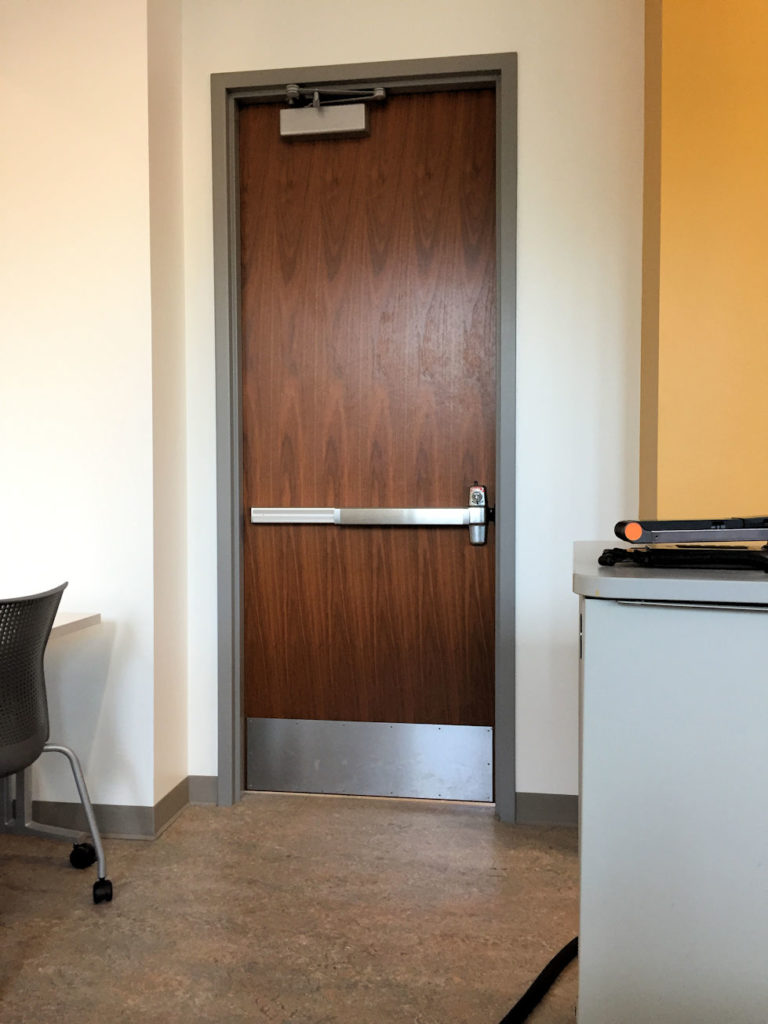
Remember the first road trip I took after I started this blog? The college-bound kid is on the right. Time flies!!
A few weeks ago I posted that our family was on a college-tour road trip, looking at schools for my oldest daughter. I really appreciate everyone’s patience as I squeezed some college visits in between work days, and sometimes responded to your emails very late at night or from a parking lot. 🙂
I also want to say “thank you” to those of you who emailed me to share your experiences with your own college searches, and to suggest colleges that we might want to visit. Several of those colleges are on the list of schools my daughter wants to apply to!
On one of the tours, we crossed paths with a security integrator who I know well. He told me that someone from the university had asked him a code question that day, and he said that I was on the campus at that moment! Imagine that you work for a university, you read iDigHardware, and you find out that I’m wandering around your campus. I’m guessing there were some mixed emotions – “Yay! I can get my code questions answered!” vs. “Oh no! What if she finds a Wordless Wednesday door?”
I’m really excited to say that I saw almost NO code issues while touring ANY of the schools. I did see Allegion hardware at just about all of them, which was very cool. As we walked around numerous campuses, I noted some of the security issues that universities face – which are much different from the challenges of K-12 schools:
- Because students, faculty, and visitors need to be able to move freely from one building to another, the perimeter security found in K-12 schools is not feasible for colleges and universities. We were able to drive in and around the grounds without being challenged – day or night. We walked freely throughout the campuses, and into many of the buildings – even on Saturdays. So what happens when there is an incident on campus and the buildings need to be locked down? Electrified hardware on the perimeter doors can help to facilitate this very quickly. Electric latch retraction panic hardware meets the requirements for egress, allows the doors to be push/pull function during normal operation, and facilitates immediate remote lockdown.
- We often talk about “layered security” for K-12 schools. With higher ed, the property perimeter layer is typically unsecured, and the ability to secure the building perimeter during an active shooter event becomes even more critical; remote locking of these perimeter doors can also help with securing the buildings during normal operation. The next layer is the ability to compartmentalize the building and secure large assembly spaces. Again, electrified hardware is a critical component of securing these doors – whether during a lockdown or when it’s time to lock the space at the end of the day. Depending on the door location and function, electric latch retraction can be a good choice, or electrified trim for panic/fire exit hardware (particularly at stairwell doors), or remote undogging products like the Von Duprin RU/RM.

This classroom door on one of our college tours has Von Duprin 99 series panic hardware with the -2 function which allows the outside lever to be locked from the inside. This hardware also has the locked/unlocked indicator (-2SI).
- With K-12 classrooms, the same teacher is often occupying the classroom and can control the locking/unlocking of the classroom door. This is not true of college classrooms, where various faculty members and teaching assistants may use any given room. We saw some electrified hardware on these rooms during our tours, and there were some classrooms with hardware that could be locked manually to prevent access – either by locking the outside trim or by undogging the panic hardware. Locked/unlocked indicators are important for these applications. For smaller classrooms where panic hardware was not required, some facilities had electrified locks like the Schlage AD/CO or NDE/LE series.
- The dormitories we visited were very well-secured. Each had a staffed desk at the entrance, and at least one of these desks had a bank of monitors for cameras on the interior and exterior of the building. All of the dorms required fob or card access – either 24 hours or at night, depending on whether the building housed dining halls or other facilities used by non-residents. Some dorms also had card/fob access to the individual floors or halls, which allowed access only to the residents of those areas. And of course, each dorm room had a lock which required a key or credential and only allowed access for the residents of that room. Many of the dorm rooms were suite-style, where two or more rooms shared a bathroom. We’ve talked about this application before, but all of the suites we toured had standard privacy sets. Another dorm-related issue that we’ve talked about is whether the door from the corridor to the room should be self-closing (as required for fire doors), or have the ability to be left open so the students can socialize. I’m pretty sure all of the dorm rooms we looked at had self-closing doors.
I’ll be writing more about some of the applications we saw on our trip over the next few weeks. And maybe when my daughter is accepted to one of these schools and moves in, I’ll be able to connect with the security department and write a more in-depth post about that particular campus’ challenges and solutions.
If you have any insight to share about security for higher education, please leave a comment!
~~~
 UPDATE: My friend Bill Elliott recognized the box from Chip Falcon’s Road Trip…here’s an updated photo from Road Trip 2018. Judging from the back of the car, I’ve lowered my organizational standards.
UPDATE: My friend Bill Elliott recognized the box from Chip Falcon’s Road Trip…here’s an updated photo from Road Trip 2018. Judging from the back of the car, I’ve lowered my organizational standards.
If you’re wondering what ever happened to Chip, the whole story is here – including a photo of Bill in the very last post. As far as I know, Chip is still performing his duties at the library in Freedom, New Hampshire. And I’m taking suggestions for next summer’s road trip. And no, I don’t know what is going on with the kid in the middle.
🙂
You need to login or register to bookmark/favorite this content.






That box looks like the one that “Chip Falcon” traveled in. I remember him.
That IS Chip Falcon’s box! The kids have changed, and look at the back of the car!
– Lori
Darn! The pic doesn’t show up! I’ll add it at the bottom of the blog post.
– Lori
Lori, YES I remember Chip and his road trip to the library, was wonderful reading that he is still going strong on his door!!
So is passing a door inspection criteria,,, for approving a college for attendance
Of course! I told my daughter that the school must have Allegion hardware but she didn’t think that should be part of the selection criteria.
– Lori
Lori,
Is there any information backing that you can modify an existing wood fire door in the field for a -2si conversion kit from von duprin I am having trouble trying to push this product with older von duprin exit devices in the field
Hi Steven –
I’m working on getting some documentation from UL on this…the main question is whether it can be done as a job-site preparation because our installation instructions show the prep, or whether it has to be a field modification because it’s not a round hole. If it has to be a field modification, I’m trying to get approval from UL so you would not have to request permission for the modification on each project individually. It make take a bit of time but I’ll get back to you asap.
– Lori